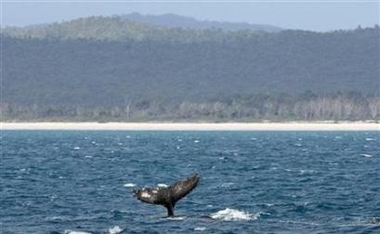Japan to resume humpback whale hunting
Updated: 2007-11-17 18:37
TOKYO - Japan is set to break a decades-old moratorium on hunting the famed humpback whale during its largest ever scientific whaling program that sets sail for the South Pacific on Sunday.
 |
Japan's whaling fleet will leave port for the South Pacific with orders to kill up to 50 humpbacks, the first known large-scale hunt for the whales since a 1963 moratorium put them under international protection.
The Fisheries Agency has refused to confirm the fleet's departure date. But the lead whaling ship's operator, Kyodo Senpaku Ltd., said Saturday the fleet was scheduled to leave the southern city of Shimonoseki.
The ships, led by the 8,030-ton Nisshin Maru, will embark on their largest scientific whale hunt ever in the South Pacific, also taking up to 935 Antarctic minke whales and up to 50 fin whales.
But it is Tokyo's plans to hunt the humpback, a favorite among whale-watchers for its distinctive knobby head, intelligence and out-of-the-water acrobatics, that has triggered condemnation from environmentalists.
"These whales don't have to die," said Junichi Sato, a Greenpeace spokesman. "Humpbacks are very sensitive and live in close-knit pods. So even one death can be extremely damaging."
Humpback whales were hunted to near-extinction four decades ago. But they have been off-limits to hunting since 1963 except for a small number caught under a subsistence whaling program by Greenland and the Caribbean nation of Saint Vincent and the Grenadines. Last year, they caught one humpback each, according to the International Whaling Commission.
The former Soviet Union also hunted humpbacks until 1973 in defiance of the ban, though it is disputed how many they killed.
Scientists say humpback whales are complex creatures that communicate through long, complex "songs." Measuring 40-48 feet long and weighing 25-40 tons, they are extremely acrobatic, often throwing themselves out of the water, swimming on their backs with both flippers in the air, or slapping the water with their tail or flippers.
The American Cetacean Society estimates the global humpback population at 30,000-40,000, about a third of levels seen before modern whaling. The species is listed as "vulnerable" by the World Conservation Union.
But Japanese fisheries officials insist both humpback and fin populations estimated at up to 60,000 are back to sustainable levels.
"Humpback whales in our research area are rapidly recovering," said Hideki Moronuki, whaling chief at the Fisheries Agency. "Taking 50 humpbacks from a population of tens of thousands will have no significant impact whatsoever."
Moronuki says killing whales allows marine biologists to study their internal organs. Ovaries provide vital clues to reproductive systems, earwax indicates age, and stomach contents reveal eating habits, he said.
Meat from Japan's scientific catch is sold commercially, as permitted by the IWC, but Japanese officials deny that profit is a goal.
Japan also argues that whaling is a Japanese tradition dating to the early 1600s, and has pushed unsuccessfully at the IWC to reverse the 1986 moratorium on commercial whaling.
Environmentalists criticize Japan's research program as a pretext for keeping the whaling industry alive, and have long campaigned for an end to the winter catch in the Southern Ocean and a mission in the North Pacific that kills about 100 minke whales a year.
Scientists note that humpbacks migrate to the southern seas from breeding grounds around the world.
"Some breeding grounds are not recovering to the same extent as others," said Ken Findlay, a whale biologist at the University of Cape Town who has studied the mammals for nearly two decades. "While the catch may be small, we're not sure where they come from. That's a real concern," he said.
Environmentalists also are critical of the methods used by Japan's fleet to harpoon the whales. Ships sometimes chase wounded whales for hours, Findlay said.
The new hunt is certain to renew Japan's angry standoff with anti-whaling forces. Greenpeace and the animal rights activist group Sea Shepherd have said they will track Japan's hunt in the South Pacific.
Japan accuses activists of "environmental terrorism." After the last Antarctic hunt, the government released video of protesters launching smoke canisters from a Sea Shepherd ship and dropping ropes and nets to entangle the Japanese ships' propellers.
"We call them terrorists because they engage in blatant terrorism," Moronuki said. "We don't want violence ... all Japan wants is to find a sustainable way to hunt a very precious marine resource."
|
|
|
||
|
||
|
|
|
|

